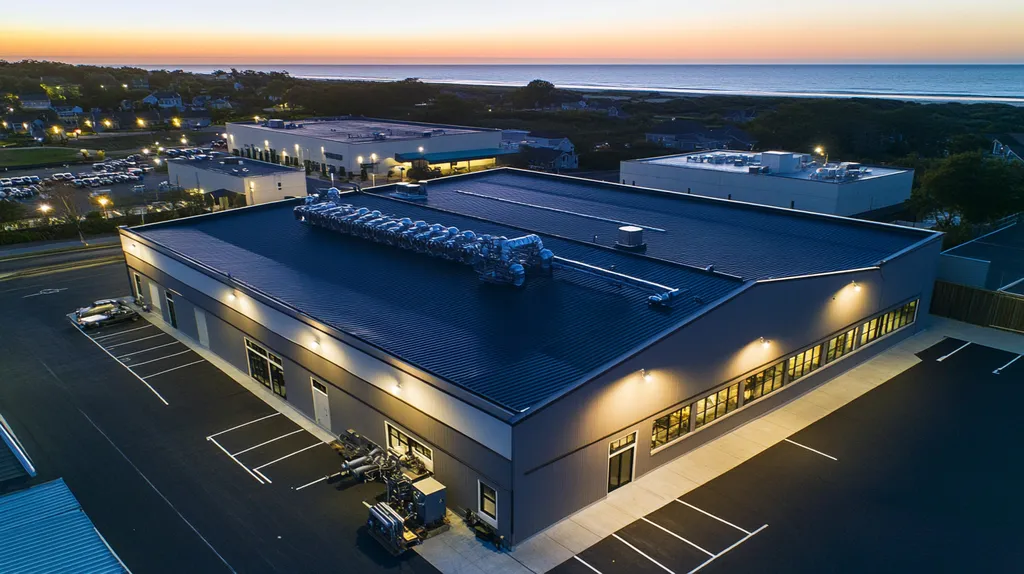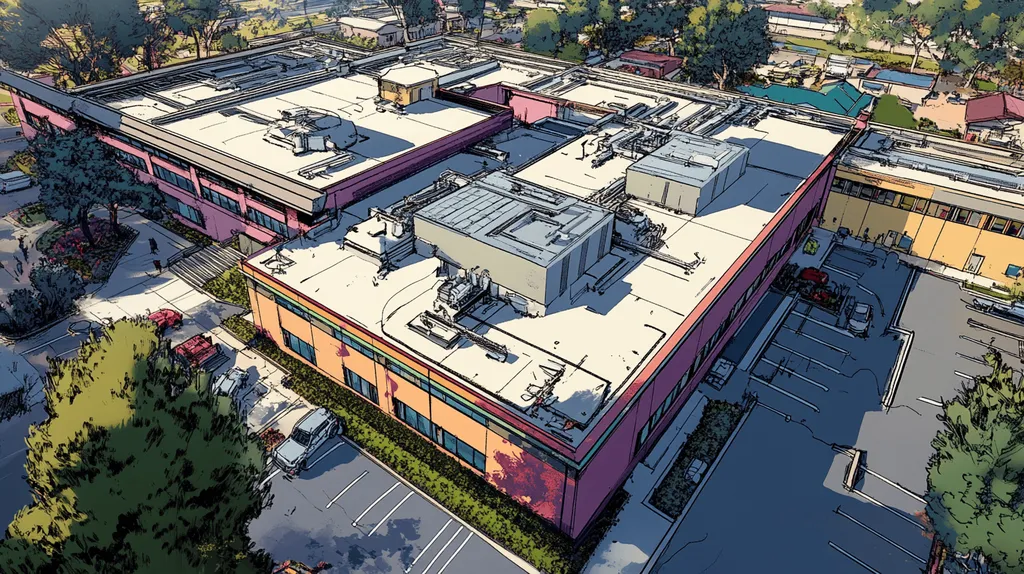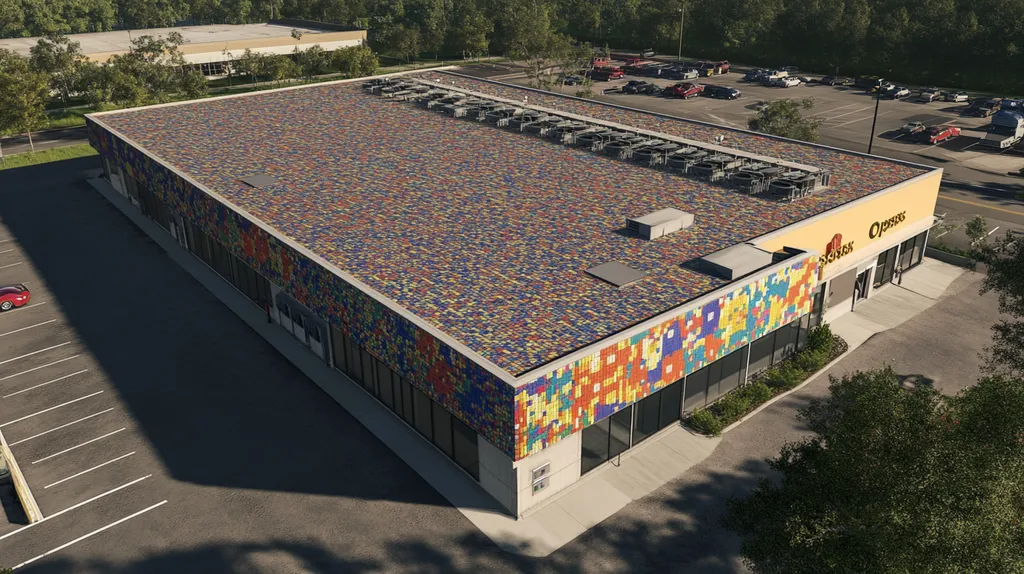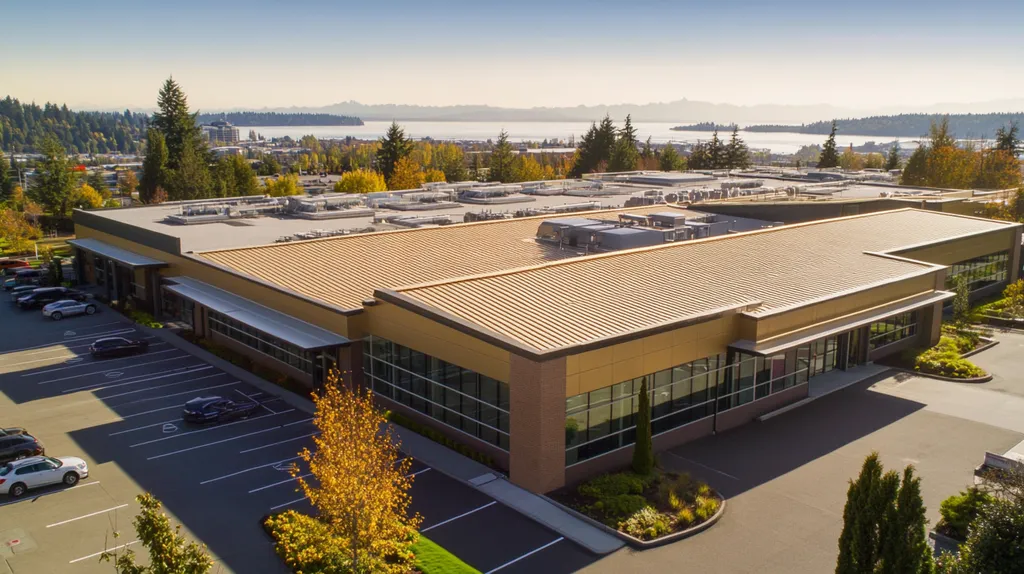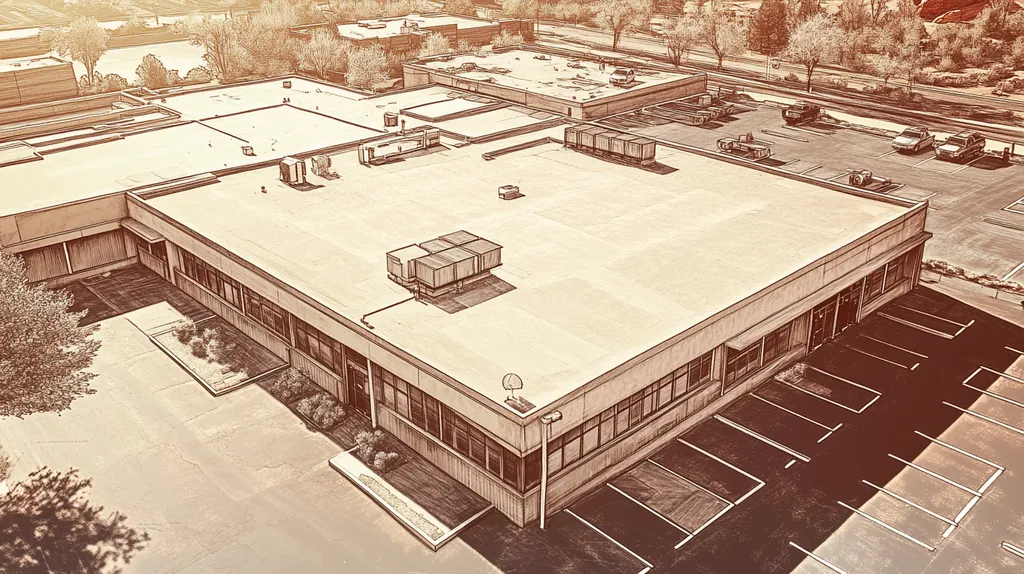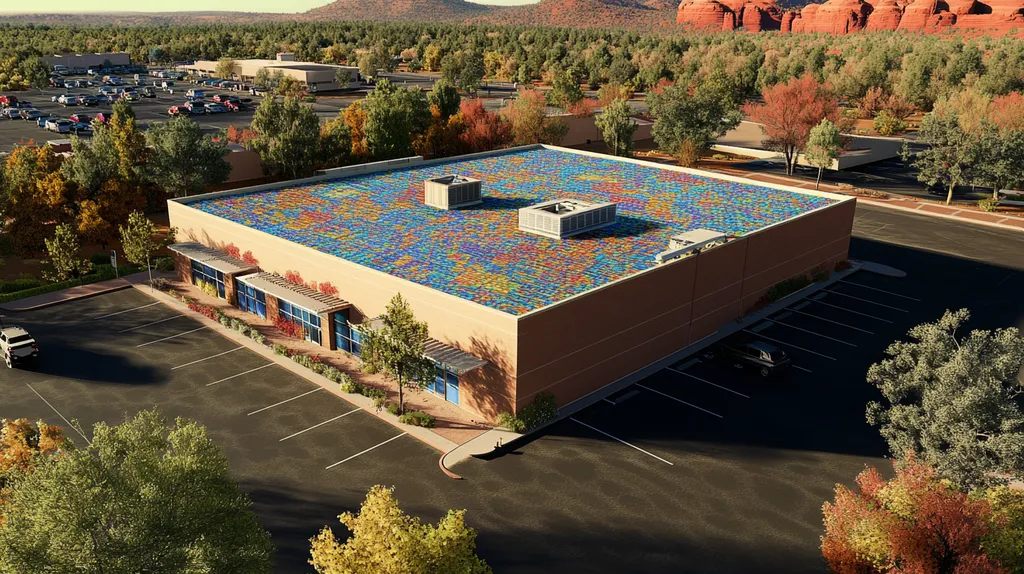In sun-scorched regions across America, commercial buildings are hemorrhaging money through their roofs. The Department of Energy reports that inefficient roofing can spike cooling costs by up to 30%, turning energy bills into profit-killers.
While every roofing vendor claims to have the ultimate solution, property owners need clear, practical guidance on energy-efficient options that actually deliver results in hot climates.
This comprehensive guide cuts through the marketing hype to explore proven roofing strategies, from reflective membranes to green roofs, helping facility managers make informed decisions that boost performance and slash operating costs.
SECTION 1: THE BASICS EXPLAINED
In scorching regions, roofing can be the make-or-break factor for energy budgets and occupant comfort. Poor roofing choices lead to cooling costs that can spiral out of control, eating away at your finances while contributing to energy waste. A startling fact from the U.S. Department of Energy reveals that heating and cooling can account for up to 30% of a building’s total energy consumption. For property owners and facility managers looking to keep costs down and optimize performance in hot climates, grasping energy-efficient roofing options is non-negotiable.
What It Is (In Plain Language)
Energy-efficient roofing consists of materials and designs crafted to minimize heat absorption while promoting cooler environments. Picture this: roofs that boast light-colored coatings or advanced materials that reflect sunlight instead of soaking it up. In climates where the sun blazes, these choices are a game changer, keeping your building’s temperature in check.
Popular options include reflective membranes, green roofs, and insulated systems. Each solution significantly reduces heat transfer, translating into real energy savings. By opting for materials designed with thermal performance in mind, property owners can enhance their roofs’ efficiency without breaking the bank.
In essence, energy-efficient roofs are engineered to counteract the sun’s relentless heat. This not only helps maintain a stable indoor climate but creates an opportunity for substantial long-term savings and improved sustainability.
In summary, energy-efficient roofing is about selecting materials that keep a building cool and cut down energy costs in hot climates. With a variety of options available, property owners can find solutions that align with both their aesthetic vision and budgetary constraints.
Why It Matters (To Your Building)
The type of roof you choose has a direct and significant impact on your building’s operating costs and occupant comfort. In hotter regions, traditional roofing often leads to rampant heat accumulation, putting unnecessary strain on air conditioning systems. This not only hikes up energy bills, but it may also compromise indoor air quality and undermine occupant comfort.
Energy-efficient roofs tackle these heat problems head-on, aiding in the longevity of HVAC systems. When cooling units can take a breather, maintenance costs dip, and the risk of system failure plummets. In the long run, well-designed roofs can effectively pay for themselves through these savings.
Moreover, adopting energy-efficient roofing aligns with broader sustainability initiatives. Buildings that lower their energy usage can shrink their environmental footprint, a critical factor for meeting regulations and tenant expectations. This commitment to sustainability can also bolster a property’s marketability and enhance its value over time.
In essence, opting for an energy-efficient roof isn’t just a smart financial decision; it’s pivotal for long-term value creation, sustainability, and ensuring occupant satisfaction. The implications extend far beyond immediate savings; they influence financial health and environmental responsibility.
How It Works
Energy-efficient roofing employs several strategies to minimize heat absorption. The magic primarily lies in reflective materials that bounce sunlight away. Think light-colored or specially coated roofs that can dramatically lower surface temperatures, reducing the influx of heat into the building.
But wait, there’s more! Insulation is equally essential. Proper insulation maintains interior temperatures by slowing the transfer of heat through the roof. This can be a game-changer, especially when it comes to cutting down air conditioning costs.
Modern innovations bring exciting options like cool roofs and green roofs. Cool roofs are equipped with coatings that reflect a significant amount of sunlight, while green roofs incorporate vegetation that offers natural cooling. Both alternative roofing types boost energy efficiency dramatically.
Furthermore, effective energy-efficient roofing systems frequently include integrated ventilation strategies. Improving airflow can mitigate heat buildup beneath the roof, enhancing overall performance. By embracing a comprehensive approach to energy efficiency, property owners can expect outstanding results.
In summary, energy-efficient roofing operates through a blend of reflective materials, insulation, cutting-edge technologies, and smart ventilation. These components work in harmony to create a roof that actively fosters energy efficiency in hot climates—essential for keeping your building cool without breaking the bank.
SECTION 2: PRACTICAL APPLICATIONS
When it comes to commercial roofing in hot climates, making the right materials and system choices is not a luxury; it’s a necessity. Neglecting to invest in energy-efficient roofing can lead to spiraling energy expenses, tenant dissatisfaction, and a drop in property value. For example, without the right insulation, a commercial building can absorb much more heat, leading to increased cooling demands and costs. Addressing these challenges isn’t merely about comfort; it’s a vital component of operational efficiency and financial viability.
Common Uses & Examples
Energy-efficient roofing finds its place across various commercial landscapes, from bustling retail hubs to expansive warehouses and office towers. Innovations like reflective membranes and green roofs are game-changers. Consider this: a retail center in Phoenix upgraded to a white reflective roof, dropping its energy costs by 20% during peak summer months. Similarly, a logistics facility embraced a green roof, benefiting from insulation while supporting stormwater management.
These practical applications do more than save on energy bills. They add value and aesthetic appeal to properties, making them more attractive to potential tenants and buyers. As energy regulations tighten, the market will see an increased shift toward these sustainable roofing solutions, proving that smart choices today set the stage for a profitable tomorrow.
When You Need It Most
Timing is everything when it comes to implementing energy-efficient roofing solutions. Commercial property owners should seriously consider these upgrades during roof replacement cycles or when faced with persistent HVAC concerns. Waiting for a roof to fail can lead to excessive downtime and inflated repair costs.
For properties in urban heat islands—think cities in the southern U.S.—the attachment of reflective materials becomes critical, especially as summer heat cranks up. Acting proactively means reaping immediate cooling rewards and long-term financial benefits.
Moreover, property managers should jump on energy-efficient solutions ahead of forecasted heat waves. Investing upfront not only mitigates future operational challenges but also enhances tenant comfort and satisfaction significantly.
Ultimately, making these smart investments translates to meaningful long-term financial gains, minimizing ongoing energy costs while boosting property appeal and marketability.
Interactions With Other Systems
Energy-efficient roofing isn’t a solo act; it’s part of a larger ensemble of building systems, including HVAC, insulation, and landscaping. Ensuring effective integration is essential for achieving optimal energy efficiency.
For example, pair a cool roof with an efficient HVAC system, and you can drastically reduce cooling loads, making energy consumption plummet. Proper insulation ensures you won’t squander the benefits of those high-performance exterior materials.
Green roofs also function synergistically, working alongside stormwater management systems to cut runoff and improve site sustainability. This interconnected approach maximizes energy savings while boosting environmental benefits.
The interplay of these systems underscores the importance of careful planning and design. It’s imperative for industry professionals to evaluate how roofing decisions affect the entire building’s energy profile, fostering smarter and more cohesive solutions.
SECTION 3: KEY TERMINOLOGY DECODED
In the world of energy-efficient roofing, a solid grasp of essential terms is not just helpful; it’s a game changer. Misunderstanding these key concepts can lead to costly blunders, wasted resources, and undesirable operating costs. For example, not knowing what “solar reflectance” means could mean missing out on significant energy savings. This section breaks down crucial industry jargon to pave the way for smarter roofing decisions that perform well in hot climates.
Essential Terms Explained
To kick off, every property owner must know what “thermal conductivity” means. This term measures how well a material conducts heat. Let’s get this straight: the lower the thermal conductivity, the better the insulation. Good insulation is vital for slashing cooling costs when the heat is on.
Next up is “solar reflectance.” This gem describes a roof’s ability to bounce sunlight back instead of absorbing it. A higher solar reflectance keeps your building cooler, translating to lower energy bills and a much more pleasant indoor climate.
Then we have “emissivity,” which tells us how well a roof can radiate the heat it absorbs. In hot climates, low-emissivity materials are your best friends—they keep heat retention at bay, boosting your energy savings.
Understanding these key terms empowers property owners to choose materials that don’t just look good, but also deliver on effectiveness.
Industry Jargon Translated
Industry jargon can feel like a different language, but cracking the code makes life easier. The term “cool roofs” refers to roofing systems specifically designed to reflect more sunlight than standard roofs. This means lower roof temperatures and decreased energy consumption for cooling—what’s not to love?
And then there’s “green roofing.” This term refers to systems featuring vegetation, enhancing not only thermal performance but also air quality and stormwater management. These roofs are a win-win, especially for those who care about the environment.
Another key term is “re-roofing,” which means replacing an entire roof rather than just patching it. This is your chance to beef up energy efficiency by incorporating cutting-edge materials and technologies. Knowing the right terms means facility managers can speak confidently about their needs.
When jargon gets translated into clear language, communication improves and project outcomes get better.
Measurement & Units Simplified
Measurement is crucial for assessing how well a roof performs. Take “R-value.” This number quantifies a material’s resistance to heat flow, which is key for understanding insulation. Higher R-values mean better insulation properties, a must-have in sweltering conditions.
Next is “reflectance,” which is expressed as a percentage. This number shows how much solar light is bounced off a surface. For example, a roof boasting 70% reflectance takes a significant load off cooling systems. Property owners should prioritize roofs with high reflectance for maximum energy efficiency.
Don’t forget “U-factor,” which measures heat transfer through your building elements. Lower U-factor values signify better insulation, putting you in a prime position for energy savings. With a grasp on these measurements, property owners can make apples-to-apples comparisons among roofing options.
Overall, simplifying measurements allows for a clear evaluation of roof performance, enabling informed choices that enhance energy efficiency.
SECTION 4: DECISION FACTORS
Choosing the right roofing system for commercial buildings in hot climates is no small feat. The consequences of poor decisions can be steep—rising energy bills, discomfort for tenants, and unexpected repair costs can make anyone’s budget break into a sweat. In fact, without energy-efficient roofing, buildings in these sweltering zones can see energy costs skyrocket by as much as 30%. This section dives into the crucial decision factors property owners need to consider: cost, performance trade-offs, and longevity.
Cost Considerations
Cost is usually the first thing that comes to mind when selecting a roofing system—understandably so. But don’t let the initial price tag overshadow the long-term benefits of energy-efficient roofs. These systems can dramatically slash cooling costs, an absolute necessity during the peak heat of summer.
For example, reflective roofs can lower energy bills by up to 20% when compared to standard options. Yes, these energy-efficient solutions may demand a higher upfront investment, but that expense should be seen as a smart move for future savings. Quality materials lead to lower operating costs over the years.
Don’t forget to explore potential federal or state incentives for implementing energy-efficient roofing. These financial perks can lighten the initial load and make better roofing options more attainable.
Ultimately, understanding the total cost of ownership—which includes installation, maintenance, and energy savings—is crucial for making wise roofing choices.
Performance Trade-offs
While energy efficiency is paramount, not every material performs alike. Property owners must consider several factors like thermal resistance, reflectivity, and durability. Some materials might excel at heat reflection but falter under extreme weather conditions.
Take white single-ply membranes, renowned for their reflective capabilities that lead to energy savings. Yet, if they aren’t properly cared for, they can suffer from UV damage. It’s essential to choose a material that strikes a balance between energy efficiency and durability.
Moreover, some roofing options come with added bonuses, such as increased insulation or resistance to wind uplift. Grasping these details can guide property owners to the perfect roof that meets both energy demands and structural necessities.
Every option has distinct performance characteristics that should be weighed carefully to ensure alignment with specific climate and environmental challenges.
Lifespan & Durability Factors
The lifespan and durability of roofing systems play a major role in determining both long-term costs and maintenance efforts. In hotter climates, roofs face relentless stress from soaring temperatures and UV exposure, so picking the right material is key to longevity.
Quality roofing can last 20 years or more, significantly reducing the frequency of uprooting and replacing roofs. More durable options resist temperature fluctuations and environmental stressors, ultimately bringing down repair costs.
Property owners should delve into warranties and the anticipated lifespan of various roofing systems. For instance, cool roofing systems often have better longevity than standard roofing because of their reflective properties and resistance to thermal shock.
In the end, selecting a roofing solution that harmonizes durability and energy efficiency not only fortifies investments but also secures a comfortable indoor environment. Finding the best long-term solution is key to achieving peak performance in hot climates.
SECTION 5: COMMON CHALLENGES
In scorching hot climates, energy-efficient commercial roofing can face formidable challenges that threaten performance and elevate costs. A shocking study reveals that subpar roofing choices can spike energy consumption by up to 30%. Property owners and facility managers can’t afford to overlook these pitfalls if they wish to safeguard their investments and extend the lifespan of their roofs. This section delves into common issues, warning signs, and preventative measures that are essential for maintaining efficiency.
Frequent Problems & Solutions
Poor insulation ranks high among the common headaches for commercial roofs. When insulation falls short, heat can seep into the building like an unwelcome guest, inflating cooling costs. The solution? Upgrade to reflective materials that act like sunblock for your roof, effectively repelling that relentless heat.
Localized damage is another frequent offender, manifesting as cracks and blisters. These nuisances compromise roof integrity and invite water in to wreak havoc. Regular roof inspections and being prompt with repairs are essential practices to catch these issues before they escalate.
Then there’s the persistent problem of membrane deterioration, courtesy of UV exposure. Nobody wants to deal with a roof that’s lost its efficacy simply because it wasn’t made to handle the sun’s wrath. Opting for UV-resistant materials can greatly extend the life and performance of your roof.
Don’t forget those pesky seams and penetrations. These are often the weak links in your roofing armor. Ensuring airtight seals around these areas can dramatically reduce leaks and bolster the overall roof performance.
Warning Signs To Watch For
Catching warning signs early can save big bucks down the line. For instance, black stains on your roof may point to water pooling, a precursor to severe damage if ignored.
Another red flag? Noticeable temperature disparities across the roof. If some sections are hotter than others, it could indicate that insulation or reflective coatings are failing.
Cracks, blisters, or peeling layers are glaring indicators that the roof is under strain. Paying attention to these symptoms can help avert further, more expensive repairs in the future.
Lastly, if HVAC systems are working overtime and energy bills are climbing, that’s a glaring signal that the roofing system isn’t hitting the mark. Regular energy audits can help catch these problems before they spiral out of control.
Preventative Approaches
A proactive maintenance schedule is your best friend when it comes to roofing challenges. Conducting regular inspections enables the early detection of potential problems, significantly extending your roof’s lifespan.
Implementing reflective coatings is also a savvy move. These coatings combat heat absorption, lowering cooling costs and proving to be a wise investment in blazing climates.
Investing in high-quality insulation materials is critical for enhancing energy efficiency. The right insulation acts as a barrier against significant heat losses, making its selection a top priority.
Finally, keep a solid line of communication open with roofing contractors. This ensures that any emerging concerns are addressed promptly, stopping minor issues from snowballing into costly repairs.
SECTION 6: NEXT STEPS & RESOURCES
As the relentless sun blazes down on commercial properties, the pressure to optimize energy efficiency escalates dramatically. In hot climates, buildings can guzzle up to 30% more energy just to keep cool. For savvy property owners and facility managers, addressing roofing performance is not just a good idea—it’s an essential move for long-term savings and sustainability. This section lays out the crucial questions to ask contractors, the industry standards to know, and valuable resources to deepen your understanding of energy-efficient roofing options.
Questions To Ask Providers
Selecting the right roofing contractor is no small task, and clarity is essential. Start by probing into the materials they recommend for hot climates. It’s vital to inquire about the energy performance ratings of these materials—particularly their Solar Reflectance Index (SRI) and insulation capabilities.
Next on the list is understanding the warranties on offer. A solid warranty should cover both material defects and installation errors, so property owners are well-protected. Don’t forget to look for a comprehensive service package that includes maintenance options—this ongoing care can greatly enhance the lifespan and performance of your roof.
Lastly, request case studies or references from previous clients who have similar needs. This provides crucial insight into the contractor’s expertise and the effectiveness of their solutions. Equipped with this knowledge, property owners can make informed and confident decisions.
Industry Standards & Guidelines
Understanding industry standards isn’t just nice to know; it’s imperative for compliance and performance. The Cool Roof Rating Council (CRRC) sets essential guidelines that help property owners select roofing materials wisely, focusing on solar reflectance and emittance—two critical factors for reducing heat absorption.
Additionally, adhering to local building codes not only ensures energy efficiency but structural integrity as well. Familiarize yourself with American Society for Testing and Materials (ASTM) standards, such as ASTM D1970 for underlayment, which can enhance overall energy performance.
Furthermore, exploring the U.S. Green Building Council’s LEED certification can help integrate energy-efficient solutions into commercial roofing projects, promoting both long-term sustainability and operational efficiency.
Further Learning Simplified
Gaining a deeper understanding of energy-efficient roofing options can lead to smarter choices. Numerous resources exist to support property owners and facility managers. The U.S. Department of Energy’s website features comprehensive guides on energy conservation strategies related to building design, including roofing.
Participating in webinars and training sessions offered by roofing associations can provide valuable insights into the latest materials and technologies tailored for hot climates. Engaging with online forums or attending local workshops also paves the way for beneficial networking opportunities.
Lastly, don’t underestimate the power of industry publications and case studies. Regularly reviewing these resources keeps property owners informed and prepares them to make impactful decisions regarding energy-efficient roofing.
The Bottom Line
With energy costs soaring and temperatures rising, commercial property owners can no longer afford to ignore roofing efficiency in hot climates.
The Department of Energy’s stark warning that inefficient roofs can spike cooling costs by 30% underscores the urgency of implementing proven solutions like reflective membranes, proper insulation, and innovative cool roof technologies.
While marketing hype promises miracle solutions, the reality is that achieving optimal energy efficiency requires a strategic combination of appropriate materials, professional installation, and consistent maintenance.
By understanding the key principles outlined in this guide and working with qualified contractors, property owners can make informed decisions that dramatically reduce operating costs while ensuring long-term performance in challenging hot climates.
The future of commercial roofing isn’t about chasing trends—it’s about implementing proven solutions that deliver measurable results in energy efficiency and cost reduction.
FREQUENTLY ASKED QUESTIONS
Q. What is energy-efficient commercial roofing in hot climates?
A. It’s roofing that minimizes heat absorption using materials like reflective membranes or green roofs. These roofs help reduce cooling costs and improve indoor comfort in scorching conditions.
Q. How can I apply energy-efficient roofing to my commercial roof?
A. Upgrading to reflective membranes during replacements or tackling HVAC issues head-on is essential. Choosing wisely can significantly cut cooling costs and improve tenant satisfaction.
Q. What key terms should I know about industrial roofs?
A. Familiarize yourself with terms like thermal conductivity and solar reflectance. These metrics are crucial for comparing roofing materials’ effectiveness and energy efficiency.
Q. What factors should I consider for a commercial roof?
A. Look at long-term costs, performance traits, and the roofing system’s expected lifespan. Prioritize materials that maintain efficiency while resisting environmental stress for durability.
Q. What common challenges might my industrial roof face?
A. Watch out for poor insulation, membrane deterioration, and localized damage. These issues can heighten energy costs and drive up repair needs—stay ahead with regular inspections.
Q. What should I ask roofing contractors for my commercial roof?
A. Inquire about recommended materials, warranties provided, and previous projects. This transparency helps you gauge their expertise and the suitability of their solutions for your needs.
Q. How can I ensure ongoing energy efficiency in my commercial roof?
A. Regular inspections and maintenance, coupled with the right insulation materials, can enhance energy efficiency. Communication with contractors also plays a key role in monitoring roof performance over time.

